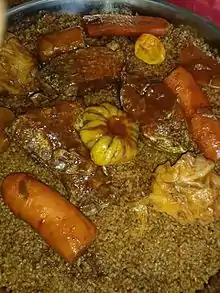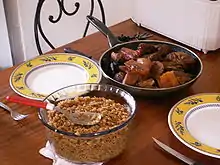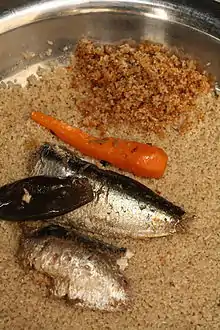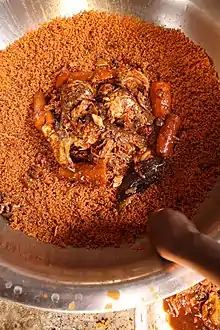Thieboudienne
Tiep or thieb is a traditional dish from the Sahel, especially from Senegal and it is a staple in Senegal.[1] The version of tiep called thieboudienne or chebu jen (Wolof: ceebu jën; French: thiéboudiène) is prepared with fish, rice and tomato sauce cooked in one pot, and it is considered the national dish. There are also tiep yappa (with meat) and tiep ganaar (with chicken). Additional ingredients often include onions, carrots, cabbage, cassava, hot pepper, lime and peanut oil, and Maggi cubes. These ingredients are common in the country.
 Tiep, made of rice, fish and vegetables | |
| Alternative names | Ceebu jën |
|---|---|
| Type | Main dish |
| Place of origin | Senegal |
| Cooking time | |
| Main ingredients | Fish and rice |
| Ingredients generally used | Vegetables |
| Variations | Meat (beef, chicken, lamb) |



Historically, tiep is commonly attributed to the city of Saint-Louis, in the nineteenth century. The name of the dish comes from Wolof words meaning "rice" (ceeb) and "fish" (jën).[2] In Pulaar it is known as maaro e liddi (rice and fish). It is served on large trays with the rice on the bottom and the fish, usually White grouper (Epinephelus aeneus), and the vegetables, many of them whole placed in the center. Tiep bears a strong resemblance—in ingredients, presentation, and significance—to Maghrebi cuscus.
Traditionally it is eaten in a large communal dish with the hand. It is also the symbol of Senegalese terranga (hospitality): Family, visiting friends, and/or guests gather around a single dish (called a bolus) from which everyone eats using a spoon (couddou Pulaar) or a piece of bread.
The Gullah dish, red rice, resembles thieboudienne, suggesting a creolization of foodways from West Africa in the New World by enslaved Africans and their descendants. Like thieboudienne , there are regional variations of red rice throughout the Gullah/Geechee Cultural Heritage Corridor, including Savannah red rice and Charleston red rice. [3][4]
Recipe
It is a preparation of fresh or dried fish, and rice (rice Wolof), cooked with vegetables (such as cassava, pumpkin, cabbage, carrot, turnip, or eggplant), parsley, tomato paste, peppers, garlic and onions. Originally made with fish, it is nowadays frequent to see it served with beef or even chicken.
Variations
By Country
Originally from Senegal, the traditional recipe includes fish, rice, tomato and onions. However, tiep is commonly consumed in several countries in West Africa. Depending on the country, the recipe and the ingredients change—even the method of cooking can differ. In Mali, tiep is known as "tieb," a dish consisting of chicken, rice and vegetables such as a tomato and onion base. Another type of tiep is the Jollof or "Djolof" (in Wolof, the national language) rice also called "Benachin" which means 'one pot' in Wolof. It is a popular dish especially in Nigeria and Ghana. The components are similar to the original recipe's ingredients with the inclusion of tomatoes, rice and onions.
.jpg.webp)
By Ethnicity
Senegal's distinctive ethnic groups have their own variations on cuisine and eating habits, influenced either by proximity to the ocean or the traditions of nomadism and cattle raising. For instance, people from southern Senegal usually also add some kouthia, while people from Dakar and Saint-Louis will use some "soul" (Wolof).
History and culture
In Senegal
The Senegalese "Teranga", or hospitality, is an important aspect of the Senegalese tradition of sharing food and cooking for your hosts, and it is very rude for a guest to refuse food, or refuse to share a meal. All are welcome to eat, even in the poorest household. It is a given that food is a blessing from God, and is here to be shared. There is always "a share for the stranger".
People take enormous pride in their welcoming tradition and go to great length in order to fulfill what is seen as a responsibility toward their guests, or even an unannounced visitor. There’s a belief that eating around the bowl means there’s always enough food for everyone rather than eating on individual plates. Eating from the bowl teaches children values. One of them is that once they have food in your mouth they have to wait for the next portion until everyone else is ready before putting their hand back in the bowl. This teaches you to be patient. When they reach into the bowl with their hand, they have to eat from the section right in front of them. They cannot reach over to the other side. They can’t eat from the middle of the bowl. That’s where all the meat and vegetables are kept. That section is for the mother. As they eat, she regularly distributes what’s at the center of the bowl to everyone eating from it, so that each person receives an equal portion. Therefore, sharing is another value learned from the bowl. Embracing teranga for the Senegalese equates to your success in life. They are taught early on to be hospitable, to be generous, to be sharing, to be grateful, to embrace others. This equates to the cooking.
.jpg.webp)
Food and religion customs
The Senegalese generally eat three meals a day. The main meal is at about 1:00 PM. Senegalese eat from a communal platter or large bowl with the right hand, as is the Muslim custom.
Benefits
Tiep consumption is understandable from the farming point of view but also from its benefits. Eating plenty of fish on a regular basis can help protect you from a range of serious diseases such as Alzheimer's, cancer or heart disease. Eating a diet rich in vegetables may reduce risk for stroke, cancer, heart diseases and type-2 diabetes. The nutrients in vegetables are vital for health and maintenance of your body. The health benefits of rice include its ability to provide fast and instant energy, regulate and improve bowel movements, stabilize blood sugar levels, and slow down the aging process, while also providing an essential source of vitamin B1 to the human body. Other benefits include its ability to boost skin health, increase the metabolism, aid in digestion, reduce high blood pressure, help weight loss efforts, improve the immune system and provide protection against dysentery, cancer, and heart disease.
Other renderings
Other renderings of the name include: ceebu jen, cee bu jen, ceeb u jen, thebouidienne, theibou dienn, thiebou dienn, thiebou dinne, thiébou dieune, tíe biou dienne, thieb-ou-djien, thiebu djen or riz au poisson.[2]
References
- "Senegalese Fish and Rice (Thiéboudienne) Recipe". Saveur. Retrieved 2019-12-14.
- Troth Wells (15 March 2007). The World of Street Food: Easy Quick Meals to Cook at Home. New Internationalist. pp. 28–. ISBN 978-1-904456-50-6.
- Jessica B. Harris (2011). High on the Hog: A Culinary Journey from Africa to America. Bloomsbury USA. pp. 71–. ISBN 978-1-59691-395-0.
- Dale Rosengarten; Theodore Rosengarten; Enid Schildkrout; Judith Ann Carney (30 September 2008). Grass roots: African origins of an American art. Museum for African Art. pp. 123, 125. ISBN 978-0-945802-50-1.
Further reading
- Senegal Travel Guide, World Travel Guide
- agricultural situation country report, USDA Foreign Agricultural Service,Mbalo Ndiaye,2007
- Food and daily life, Our Africa
- Duffy, Megan, "Ceeb ak Jën: Deconstructing Senegal’s National Plate in Search of Cultural Values" (2009). Independent Study Project (ISP) Collection. Paper 669.